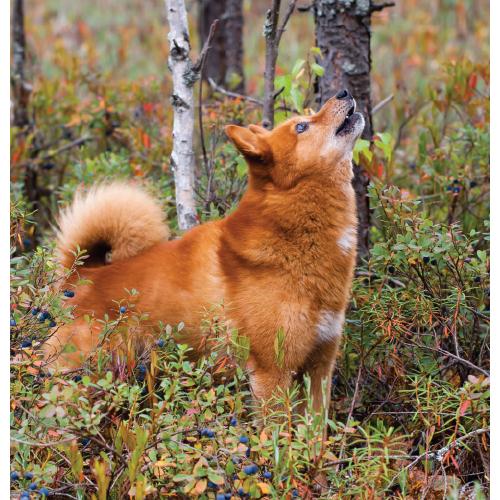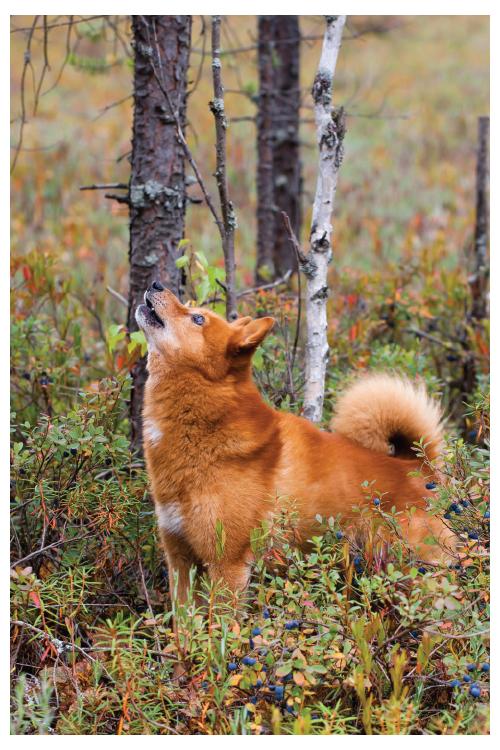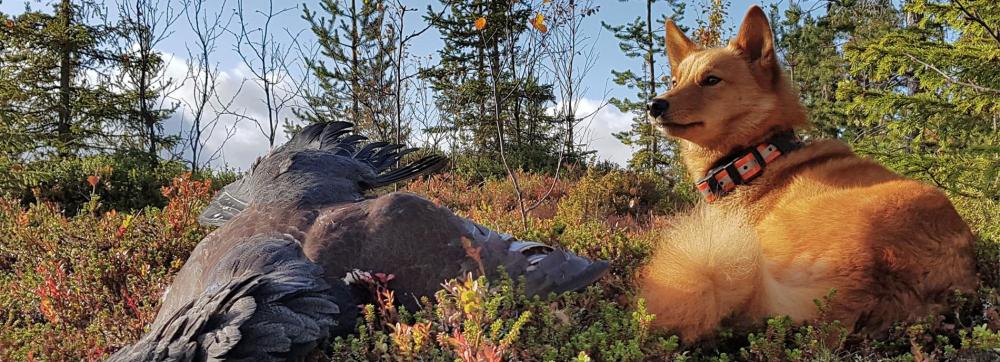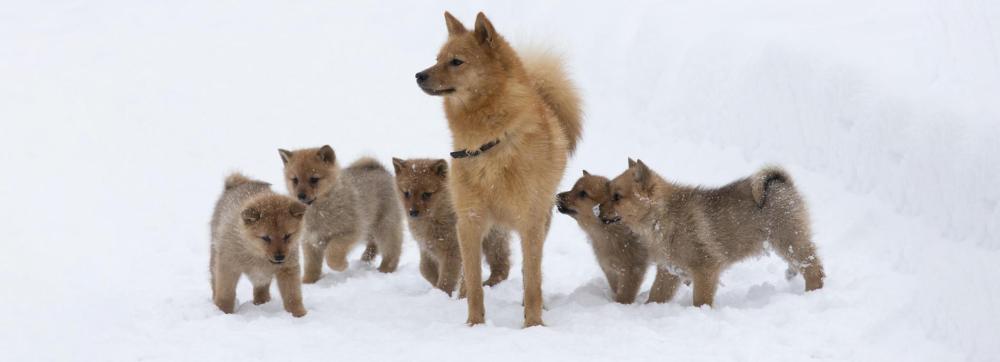The following article by Katariina Mäki 2021 offers in-depth information on development of the Finnish Spitz Breeding Strategy.
The article is presented in 3 parts.
Part I. Tackling the main health conditions
Part II. Success story regarding epilepsy
Part III. Increasing and maintaining genetic diversity
Part III.
Increasing and maintaining genetic diversity
Katariina Mäki 2021
“The pursuit of a certain type of ideal dog reduces genetic diversity. When phenotypes become similar, also genes become similar, and the diversity decreases. Although (line-)inbreeding is no longer used in the breed and winning dogs’ widespread use has indeed diminished, pursuit of homogeneity itself narrows the gene pool. The strongest factor guiding the breeding is competition, whether in appearance or in working traits.
“By setting various breeding criteria and recommendations, there is a risk that the gene pool will be further narrowed if potential breeding dogs are excluded from breeding. The health and well-being of dogs as well as working traits are the most important criteria. Compromises can be made on less important traits.
“If the gene pool of a breed is already substantially narrowed, it cannot be re-expanded without introducing genes from outside the breed.”
(Quotes from the Finnish breeding strategy of the Finnish Spitz)
Nordic collaboration
All the Nordic breed associations have worked effectively for years to widen the gene pool of the breed. They have introduced maximum limits for the numbers of offspring per individual dogs as well as for the inbreeding coefficient of the litters. They have also encouraged owners to use their dogs for breeding and thus to increase the number of breeding dogs in the breed.
This article is about increasing and maintaining the genetic diversity of the Finnish Spitz in Finland. To read about other Nordic countries’ strategies and statistics, please see Get a GRIHP! on Finnish Spitz (Globally Relevant Integrated Health Profile (GRIHP) for the Finnish Spitz) on DogWellNet.com.
History to the present
 The Finnish Spitz was formed from only a few dozen landrace dogs, sometimes even using heavy inbreeding.
The Finnish Spitz was formed from only a few dozen landrace dogs, sometimes even using heavy inbreeding.
Between 1950 – 1990, popular sires were used widely, as dangers of small gene pools were not widely recognized or acknowledged. Heavy use of popular sires in a closed gene pool decreases the genetic diversity and increases inbreeding, allowing recessive problems to surface.
From the beginning of 1990s, different sires have been used more evenly for breeding. The Breed Association set a recommended limit for the maximum number of offspring for an individual dog.
In 2006, the cross-border Russian population that is, according to local estimates, growing strongly, was added to the Finnish Spitz population to widen the gene pool. This is worthy of note as many other breeds are in the same situation, state borders dividing into two populations groups that were previously one and the same. The Finns were able to admit that this incorporation needed to be done, to increase the genetic variation in the breed. Russian dogs have not been used much in breeding, however, but enabling their use is a possibility, quite a rare one these days, when the tendency in pedigree breeds has been rather to close the registries, not open them.
Also in 2006, a limit to the number of offspring was set: at most 70 offspring could be registered in the Finnish Kennel Club for an individual Finnish Spitz dog. The litter, in which this limit is reached, is, however, registered as a whole.
In 2009, a limit was set also to the maximum inbreeding coefficient of a litter: 6.25 % (calculated from 7 generations). Litters with a higher inbreeding coefficient are not registered in the Finnish Kennel Club.
“When two closely related individuals are combined, there is an increased likelihood that the resulting offspring will receive the same harmful alleles from both their parents.” (Finnish breeding strategy)
In 2012, a survey of DLA haplotypes revealed a high degree of homozygosity in the breed. The higher the degree of homozygosity, the higher also the probability of single-gene disease inheritance. As also the number of dogs born and registered had more than halved during the 2000s compared to the peak years, the Finnish Breed Association decided in its’ breeding strategy that “special attention should be paid to the size of the gene pool. It is good to keep the number of offspring of an individual male relatively low and it is good to divide the litters into several years. The aim should be to maintain the widest possible gene pool for the breed so that genetic diversity is not lost. The number of different males used for breeding should continue to be actively increased.
Starting from 2016, at most 50 offspring could be registered for an individual dog in this breed. The Breed Association takes the idea even further in its’ recommendations in the breeding strategy: “In addition to the number of males used for breeding, the number of their second-generation offspring also describes the allele dose that an individual male brings to the population. This, too, should not grow too much, but on the other hand, males with many second and third generation offspring are likely to have proven to be good heirs. When giving breeding advice, it is important to keep in mind that males with abundant offspring should not produce too many second-generation offspring. From the history and pedigrees of the Finnish Spitz, we know that this can affect the gene pool and reduce genetic diversity.”
In 2017, a research paper by Kumpulainen et al. revealed that the genetic diversity of the Finnish Spitz is still low: "We found that the Finnish Spitz has undergone repeated male bottlenecks resulting in dramatic loss of genetic diversity, reflected by 20 effective founders (fa) and mean heterozygosity (Hz) of 0.313. The realized effective population size in the breed based on pedigree analysis is 168, whereas the genetic effective population size (Neg) computed the decay of linkage disequilibrium (r2) is only 57 individuals.
Currently, the Breed Association recommends that functional and typical-for-breed individuals be used for breeding, hoping also that breeders will actively seek to maintain breed diversity by favoring less related and less used individuals in breeding. The Breed Association is planning to further decrease the number of registerable offspring for an individual dog, from 50 to 40. This will intensify the maintaining of genetic diversity.

Photo: Kaisa Huttunen
Decrease of the average inbreeding level and improvement in the litter size
The narrowing of the gene pool is an issue the Breed Association has worked against for years. The new breeding strategy (2021) warns: “As the gene pool narrows, also the diversity of litters decreases inevitably. Narrowed gene pool and elevated inbreeding coefficient of the breed affects fertility. With a high level of inbreeding, it is difficult for the bitches to become pregnant. Litter sizes will remain small. There are also more dead puppies."
Now, the average (short term) inbreeding coefficient is decreasing, while at the same time the average litter size is increasing. The increase started already after the year 2004, which is exactly the point when the inbreeding coefficient went down from 4 – 6,25% to below 2 %. It seems that genetic diversity has somewhat increased, with positive effects on litter size. This will likely have similar effects to all reproduction traits of the breed.

Current rules and recommendations regarding genetic diversity
There is still lots to do to increase the genetic variation in the breed. Currently, both the number of offspring per individual dogs and the inbreeding coefficient of litters are being limited in registration of litters, as written above. The Breed Association plans to lower the former even more, to 40 offspring. During the past few years, also crosses with another breed have been discussed as one possible tool to increase the genetic variation in the breed.
Besides the rules affecting the registration of the litters, the Breed Association has additional recommendations to prevent or reduce the increase of inbreeding:
-
maximum inbreeding coefficient of a litter should be smaller than 3.0 % (calculated from 7 generations), with influence from a single ancestor at most 1.0 %.
-
in a 7-generation pedigree, the number of different individuals should be at least 180 (of 254).
-
mating combinations should not be repeated.
To increase the number of breeding dogs:
-
a maximum of two litters per year is recommended for one male. The organization recommends less used males for breeding. Similarly, more females should be used for breeding, if possible. Rare breeding combinations are preferred.
Improving the health of pedigree dogs
While there is controversy and discussion internationally on how to measure genetic diversity and how best to improve it, the Finns have moved ahead to improve the health of pedigree dogs and to protect and sustain their national breeds. This work is aided, in fact dependent on, for example:
-
Linked health and pedigree database provided by the Finnish Kennel Club, which is fully open and transparent
-
A long history of creation of breed-specific breeding strategies
-
Open-mindedness about health issues and aim to work for the best of the dogs.
“The most important thing is to take care of the whole breed. The gene pool must be kept large enough and refrain from overuse of males. Choices made in breeding must safeguard the genetic diversity and good temperament of the breed. It is particularly important to remember the special status and our basic responsibility to maintain the breed as our living cultural heritage. Let’s keep this wonderful breed viable for the next 100 years as well!”
References
DogWellNet 2021. Get a GRIHP! on Finnish Spitz – Globally Relevant Integrated Health Profile (GRIHP) for the Finnish Spitz.
Finnish Breed Association: Suomen Pystykorvajärjestö – Finska Spetsklubben.
Kumpulainen et al. 2017. Founder representation and effective population size in old versus young breeds—genetic diversity of Finnish and Nordic Spitz. Anim. Breed. Genet. 134(5): 422 – 433. doi.org/10.1111/jbg.12262.
 Donate
Donate
 The Finnish Spitz was formed from only a few dozen landrace dogs, sometimes even using heavy inbreeding.
The Finnish Spitz was formed from only a few dozen landrace dogs, sometimes even using heavy inbreeding.


Recommended Comments
There are no comments to display.
Join the conversation
You can post now and register later. If you have an account, sign in now to post with your account.
Note: Your post will require moderator approval before it will be visible.